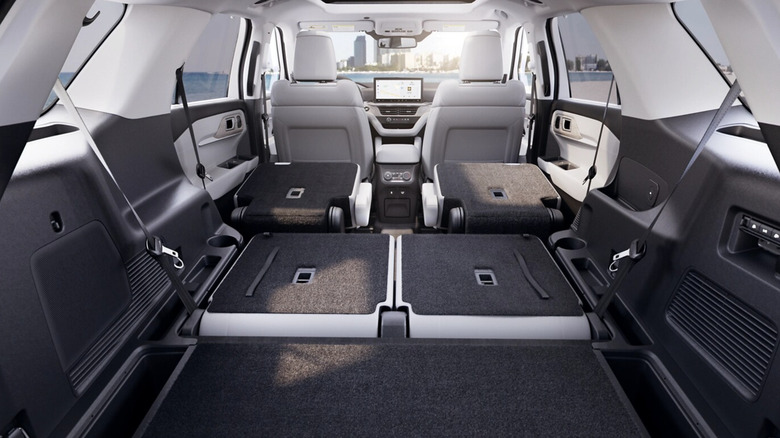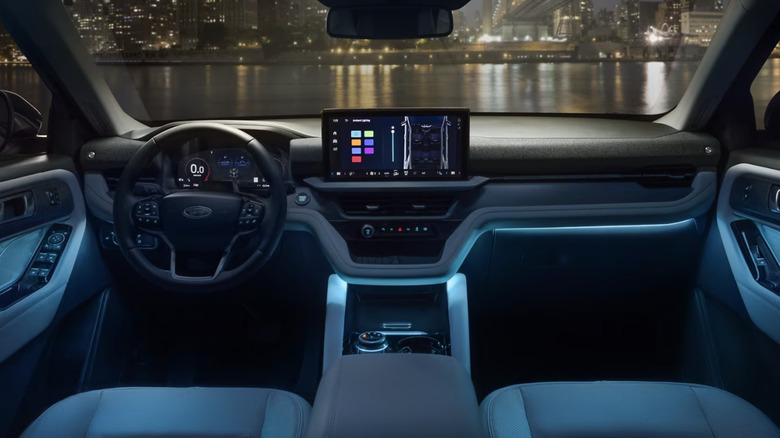Ford Explorer Vs. Toyota Highlander: How Do These Midsize SUVs Compare?
Sitting squarely in the middle of the spectrum between compact and full-size SUVs, mid-size SUVs are well known for their versatility with the towing capacity and ample cargo volume of a larger vehicle but at a much lower price point. Yet in today's industry this particular class is also one of the most competitive with a number of different brands vying to provide an ideal, family-centric vehicle. Within this market, both Ford and Toyota have consistently earned high ranks in delivering quality mid-size SUVs that strike a balance between utility and maneuverability around urban areas. Specifically, two mid-size models that have performed well in this sector are the Ford Explorer and the Toyota Highlander.
Both automakers have been focused on the release of the latest iterations of their respective models, with the 2025 Ford Explorer hitting markets in the second quarter of 2024 at suggested retail prices ranging from $39,755 to $54,160 depending on the trim package. On the other hand, in celebration of its 25th anniversary, the 2025 Toyota Highlander is not expected to hit U.S. markets until November 2024.
Although no official prices are listed, the new Toyota Highlanders are expected to have an estimated cost of $40,000. Over the course of their respective runs, both models have built up solid reputations and attracted a significant portion of the target consumer audience. In fact, in 2023 the Ford Explorer and Toyota Highlander each received an 80 overall consumer rating from J.D. Power. This article takes a closer look at the specifications, comparing the prospective pros and cons of each model.
The Ford Explorer is one of the longest-running SUV models in the U.S.
First appearing in 1991 to sub out the Bronco II, the Explorer is contributed as one of the successful pioneers that popularized the sport utility vehicle class in the North American market. Essentially, the first iterations of the model in the '90s were a hybridization of preceding Ford vehicles. The Explorer consisted of an eye-catching boxy frame based off of the Ford Ranger. It was built on top of the Bronco's framework with ample cargo space to rival that of a station wagon, which at the time were considered the equivalents of minivans by the public.
In fact, the first Explorer was available in either two or four-door iterations, which made it considerably larger in size than its truck originator. Over the generations, the Explorer has continued to evolve with the changes in automotive engineering and technology, and is now ranked among the four longest-running models continuously sold in the U.S., along with its siblings the Expedition and Mustang.
Throughout the duration of its run, the Explorer has carved out some pretty specific consumer segments. When Ford originally launched this Explorer, the ads and marketing campaigns targeted young families that were interested in a vehicle that touted reliability and comfort, but also promised plenty of adventures off-road. Today, that description remains pretty much the same, with ages under 44 making up approximately 32% of the consumer audience. Ford has made attempts to branch out to other market segments with new derivatives, such as providing a utility crossover alternative to blue-collar workers with the now discontinued Ford Explorer Sport Trac. However, they have not reached the same level of sustained success as the original Explorer.
The Toyota Highlander is the originator of the SUV unibody design
Roughly a decade after the launch of the Ford Explorer, the Toyota Highlander made its U.S. debut in 2001 serving as a test pilot for the Japanese automaker's first foray into the sport utility vehicle class. In much the same way the Explorer brought the SUV class into vogue, the Highlander is also attributed as the originator of the unibody design configuration for SUVs, which at the time was more commonly used for sedans and compact cars. Interestingly, because Hyundai had already trademarked "Highlander" as a trim in both Japan and Australia, Toyota released the Highlander in those markets under the name "Kluger" — a play on the German word klüger which means "smarter." Over its decades-long run in circulation, the Highlander has proven a formidable member of the mid-size SUV class, known as an enduring performer that's 1.8 times more likely to last beyond 250,000 miles.
Since the first generation of the model was built upon the architecture of the pre-existing Camry, the original target audience for the Toyota Highlander were families looking for spacious and efficient SUVs with the nimble maneuverability of a compact car. With each new iteration of the Highlander the model has remained family-centric although the general consumer description has morphed into young owners with families and active lifestyles that may include outdoor activities. Other additional target audiences for the Highlander in today's market include tech-enthusiasts interested in cars with cutting-edge gadgets and owners interested in fuel efficiency for their daily commute to work.
The hybrid trims of Toyota Highlander touts premium efficiency
Fuel efficiency is one of the most critical factors consumers consider when evaluating mid-size SUV options. On average, the standard model's fuel economy lands within the range of 18 to 22 mpg, with outlier hybrids able to boost that number up to about 30 mpg. Looking at the Toyota Highlander line-up for 2024 more than two-thirds of the variants in circulation were hybrid models propelled by a 2.5-liter L4HV 16-valve D-4s injection engine capable of reaching 260 horsepower. All of these iterations from the Hylander Hybrid E and XLE to the Premium consistently reached an overall efficiency of 36 mpg, well beyond the average fuel economy for these vehicles. On the other hand, the combustion engine variants of the Highlander scored an efficiency rating of 25 mpg, with that number bumping up to 29 while on the highway.
Interestingly, Ford has decided to drop the hybrid powertrain for the 2025 Explorer iteration, with an exception for its line of police utility vehicles. But when you look at the fuel economy stats, it's hard to justify such a decision, with the hybrid variants attaining an efficiency of 28 mpg in the city and 30 while on the highway. For the standard ICE Explorers, the overall fuel efficiency lands at 24 mpg with maximums reaching 28 mpg on the highway and 20 in the city — give or take a couple integers depending on whether the trim is AWD or FWD. So overall, the Toyota Highlander does have an advantage with its strong hybrid technology, but both Explorer and Highlander are fairly evenly matched when it comes to their combustion variants.
Ford Explorer comes out on top with greater cargo volume
Another important factor to take into consideration is the space and comfort of the mid-size SUV so that you can strike a balance between efficiency and hauling capacity. A lot of additional elements such as the seating layout and the number of passenger rows can impact available interior space. The general range of expected cargo capacity in a mid-size SUV tends to be around 15 to 30 cubic feet. Since Toyota ushered in the fourth generation of the Highlander, they have pushed for contemporary models to have a sleeker, aerodynamic body with an enlarged cargo volume. The result in the 2024 model has been a space of 16 cubic feet of storage behind the third row and 48.4 cubic feet behind the second, totaling out to 84.3 cubic feet worth of cargo volume.
In comparison, the 2024 Ford Explorer offers roughly 2 more cubic feet in third-row cargo space with 18.2 cubic feet and 47.9 cubic feet behind the second-row. Additionally, the Explorer offers 39 inches worth of legroom in the second-row, which is a pretty good indicator of comfort that just slightly lands above the Highlander with its 38.7 inches of second-row leg space. General reviews have praised the Explorer's ample space to move in the first two passenger rows, while the third row does tend to get a bit cramped. This is most likely due to the compromise in order to achieve greater rear cargo volume.
Both are equipped with modern tech and safety features
While the more utilitarian aspects like interior measurements and fuel efficiency are worth considering, we can't overlook the innovative touches that can effectively pique the consumer's interest. In that regard, both the Ford Explorer and the Toyota Highlander come well stocked with a suite of the latest tech and safety features. The 2024 Explorer comes outfitted with an array of cutting-edge systems including adaptive cruise control, pre-collision assist, and the new BLIS (Blind Spot Information System) which notifies the driver of cars passing through blind spots. The dashboard comes equipped with a 10.1 inch LCD vertically-oriented touchscreen that includes Pilot360 for premium navigation and SYNC3, which enables a broad range of connectivity mediums from Apple CarPlay to Android Auto. Moreover, drivers can download the FordPass app on their phone for more individualized customization.
In the Toyota Highlander, the infotainment center features a smaller, 8-inch touchscreen, with customers having the option of purchasing the larger 12.3-inch screen that comes standard in the Grand Highlander. However, like the Explorer, the Highlander's infotainment center emphasizes versatility as the system also includes both Apple CarPlay and Android Auto for easier customization based on the driver's mobile device. In addition, consumers can subscribe to the Toyota app that further expands modification including the Remote Connect, which essentially transforms their smart device into a key that can lock or unlock the Highlander remotely. Similar to the Explorer, the Highlander also comes equipped with a number of safety features and alert systems, as well as front and rear parking assist that automatically brakes if the vehicle is about to hit a nearby object. Overall, both the Explorer and Highlander are fairly evenly matched when it comes to sporting the latest in cutting-edge technology & safety systems.





